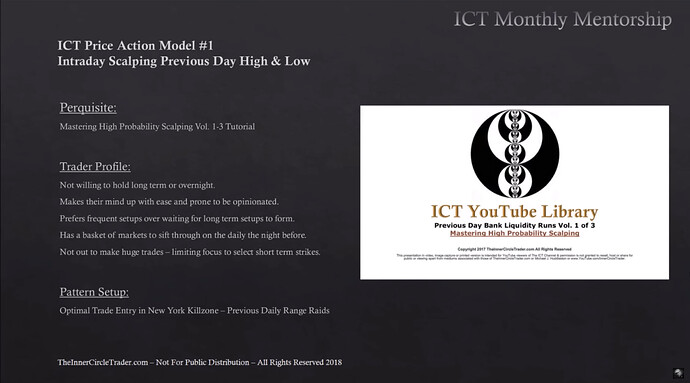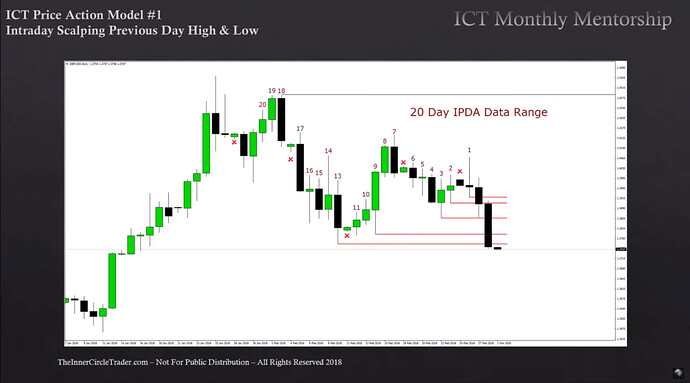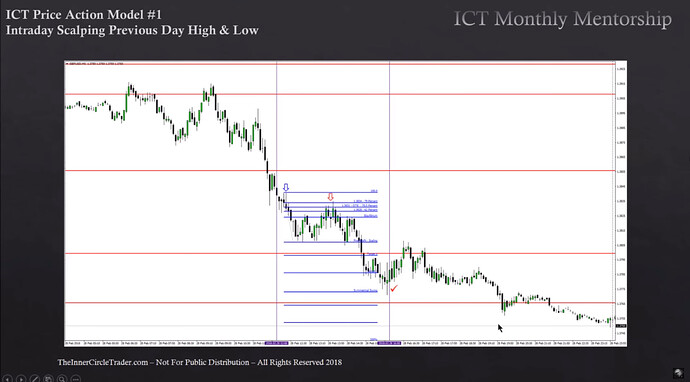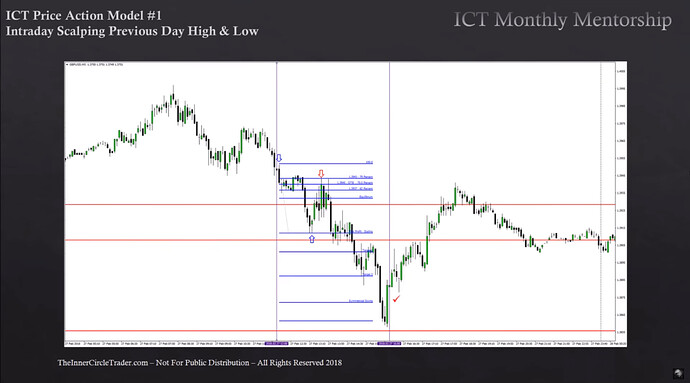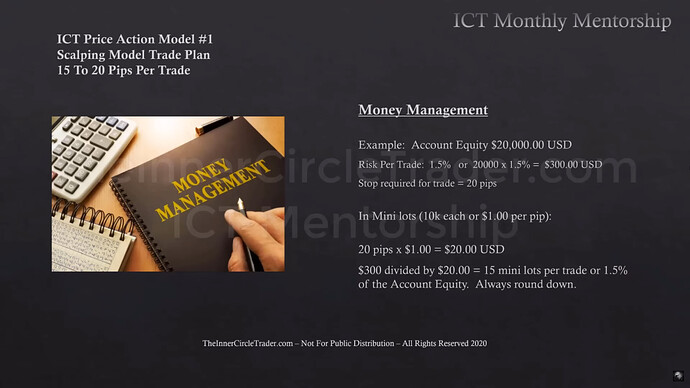Foundation Presentation
Amplified Teaching
Trade Plan & Algorithmic Theory
Notes
- This price action model builds on Mastering High Probability Scalping series.
- When we mark a dealing range using the Fibonacci tool, we always use candle wicks.
- When we look for OTE levels, we apply the Fibonacci tool to the candle bodies.
- Trading plans should be concise and fit on the back of a business card. They should also be tailored to individual experiences and comfort levels with various ICT tools.
- Understanding institutional order flow is crucial for developing a trading model. It helps identify where to enter and exit trades.
- ICT tools (concepts) should be used when applicable. Not all tools are necessary for every model.
- The ICT Mentorship Core Content lays the groundwork for understanding price action and these trading models.
- In the Mastering High Probability Scalping series, swing points were used to determine entry and exit points. The strategy includes buying when a swing high is broken and a swing low is formed, or selling short when a swing low is broken and a swing high is formed.
- The Amplified Teaching lecture discusses refining this model to anticipate market movements before swing points form. Michael claims that it should enhance precision and entry points.
- The refined scalping model uses IPDA data ranges to identify key support and resistance.
- Our primary focus should be on mastering one setup per week, achieving consistent returns, and gradually increasing complexity as experience grows.
- A simple, well-understood model can be more effective than complex strategies.
- As traders, we do not need external validation of our trading models. Success is determined by consistent application and sample size data.
- When we expect the report (news) at 10:00 a.m. or 10:30 a.m., the New York Kill Zone can be extended until 11:00 a.m.
- Michael likes to reduce his risk per trade by half after five winning trades.
- Backtesting is vital to mastering and gaining confidence in any price action model.
- Algorithm is a set of instructions designed to perform a specific task and or solve a problem.
ICT Price Action Model 1 - Intraday Scalping Previous Day High And Low
Intraday Scalping Previous Day High And Low - Setup Overview
Intraday Scalping Previous Day High And Low - 20-Day IPDA Data Range
Intraday Scalping Previous Day High And Low - ICT Price Action Analysis
Intraday Scalping Previous Day High And Low - Previous Lows
Intraday Scalping Previous Day High And Low - Previous Daily Lows And NY Midnight Open
Intraday Scalping Previous Day High And Low - Defining Buy Programs
Intraday Scalping Previous Day High And Low - Buy Entry Process
Intraday Scalping Previous Day High And Low - Long Stop Loss Placement
Intraday Scalping Previous Day High And Low - Long Position Targets
Intraday Scalping Previous Day High And Low - Defining Sell Programs
Intraday Scalping Previous Day High And Low - Short Entry Process
Intraday Scalping Previous Day High And Low - Short Stop Loss Placement Process
Intraday Scalping Previous Day High And Low - Short Position Targets
Intraday Scalping Previous Day High And Low - Following The Elephant
Intraday Scalping Previous Day High And Low - GBPUSD Short Trade Example
Intraday Scalping Previous Day High And Low - GBPUSD Short Trade Example 2
Intraday Scalping Previous Day High And Low - GBPUSD Short Trade Example 3
Intraday Scalping Previous Day High And Low - Grading Price Swings
Amplified Teaching - Dealing Range, Premium And Discount
Amplified Teaching - Refined Dealing Range
Amplified Teaching - Optimal Trade Entry
Trade Plan & Algorithmic Theory - Trade Stages
Trade Plan & Algorithmic Theory - Economic Calendar
Trade Plan & Algorithmic Theory - IPDA Data Range
Trade Plan & Algorithmic Theory - Daily Bias
Trade Plan & Algorithmic Theory - Anticipation Of Price Movement
Trade Plan & Algorithmic Theory - Liqudity Pools
Trade Plan & Algorithmic Theory - PD Arrays
Trade Plan & Algorithmic Theory - Manipulation
Trade Plan & Algorithmic Theory - Short Trade Entry
Trade Plan & Algorithmic Theory - Long Trade Entry
Trade Plan & Algorithmic Theory - Short Trade Targets
Trade Plan & Algorithmic Theory - Long Trade Targets
Trade Plan & Algorithmic Theory - Long Trade Execution
Trade Plan & Algorithmic Theory - Short Trade Execution
Trade Plan & Algorithmic Theory - Short Trade Entry Price
Trade Plan & Algorithmic Theory - Short Trade Target Prices
Trade Plan & Algorithmic Theory - Short Trade Stop Loss
Trade Plan & Algorithmic Theory - Long Trade Entry Price
Trade Plan & Algorithmic Theory - Long Trade Target Prices
Trade Plan & Algorithmic Theory - Long Trade Stop Loss
Trade Plan & Algorithmic Theory - Stop Loss Management
Trade Plan & Algorithmic Theory - Position Size Calculation Formula
Trade Plan & Algorithmic Theory - Position Size Calculation Example
Trade Plan & Algorithmic Theory - Position Size Calculation Example 2
Trade Plan & Algorithmic Theory - Position Size Calculation Example 3
Trade Plan & Algorithmic Theory - Risk Reduction When Losing
Trade Plan & Algorithmic Theory - Risk Reduction When Winning
Trade Plan & Algorithmic Theory - Backtesting
Intraday Scalping Previous Day High And Low (PAM1) - Bullish And Bearish Algorithmic Theory
Next lesson: ICT Price Action Model 2 - Short Term Trading



